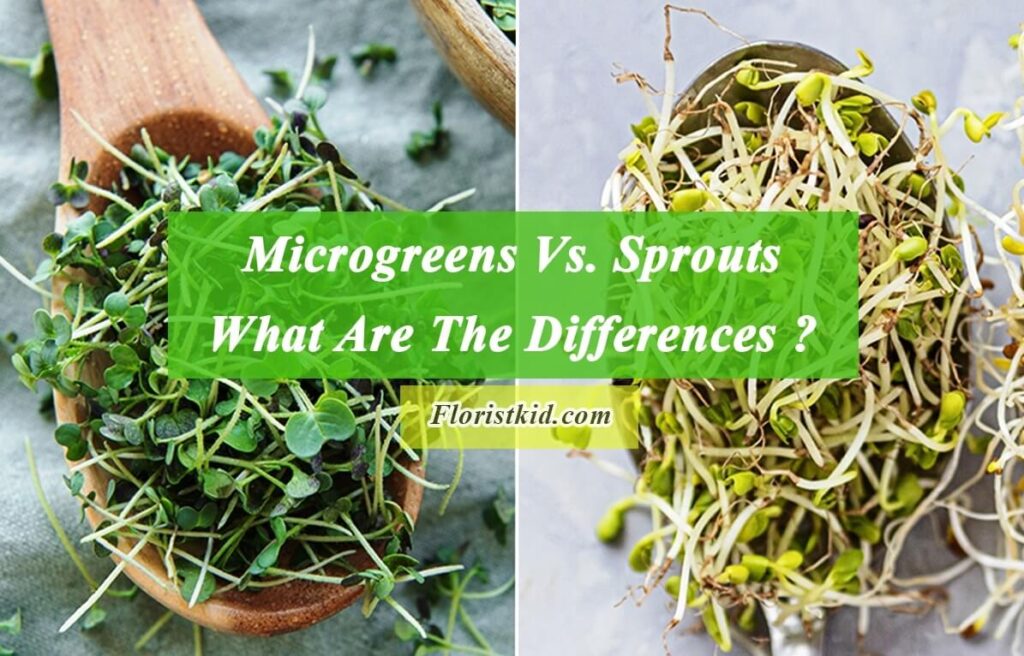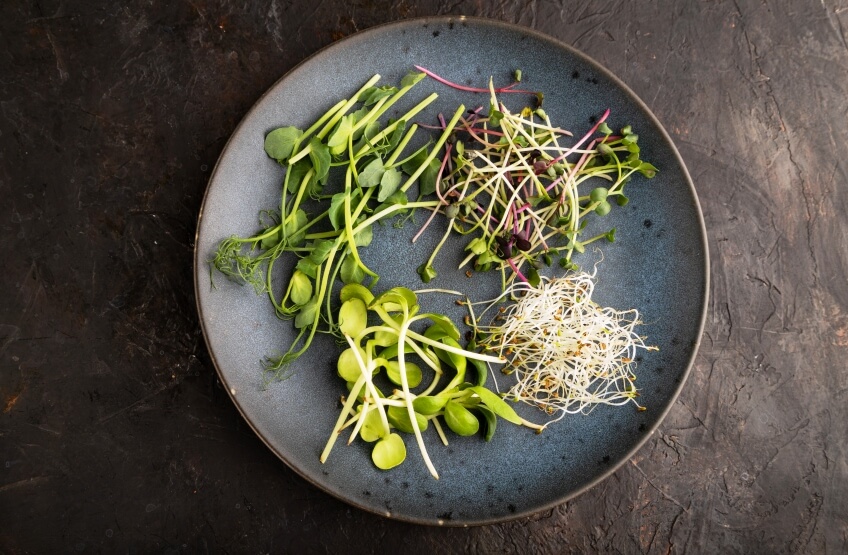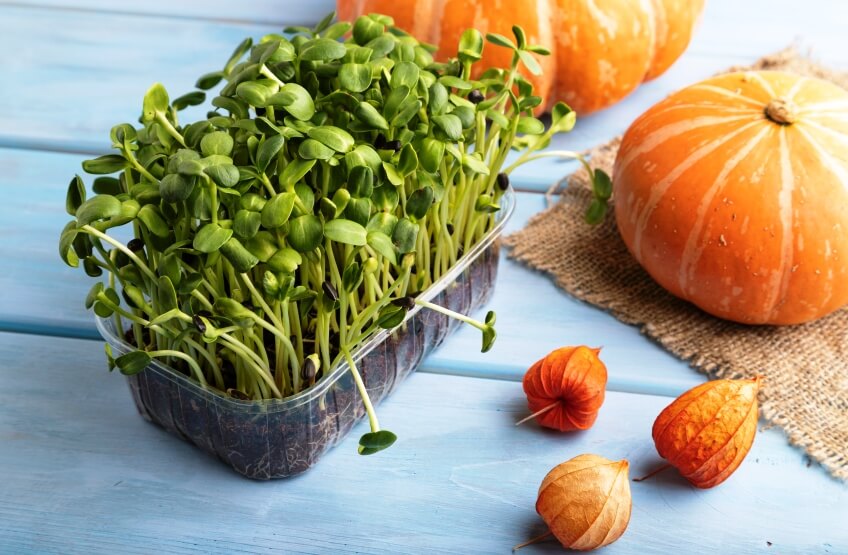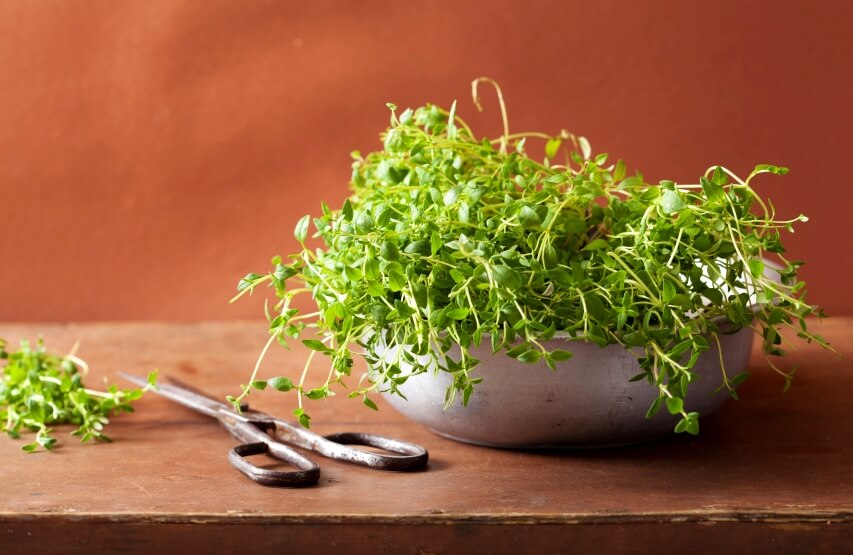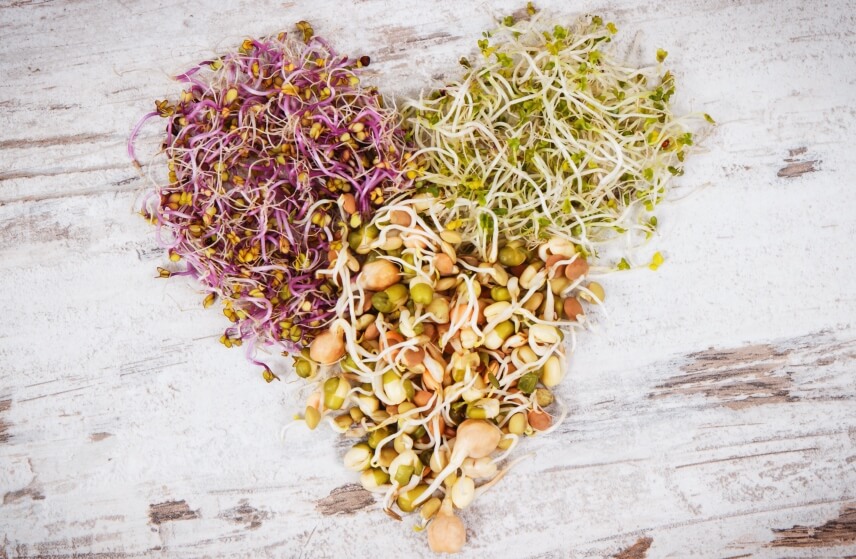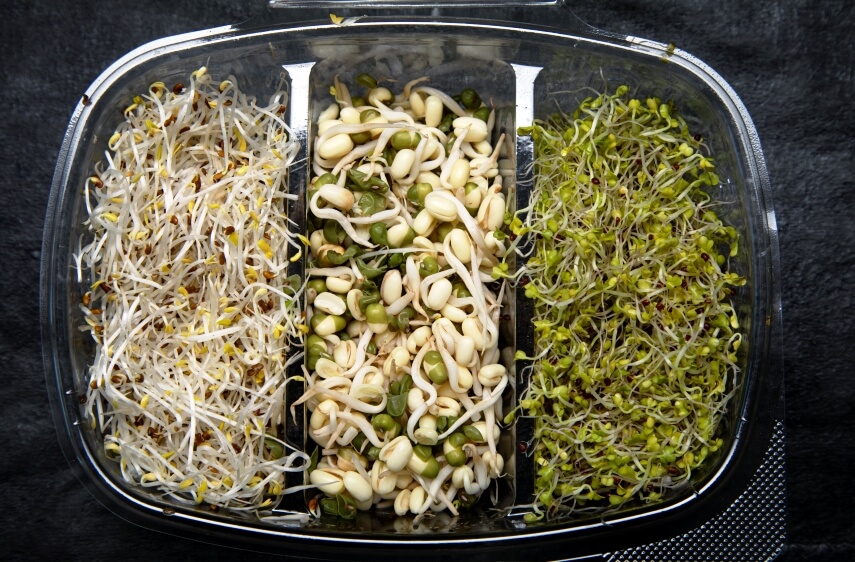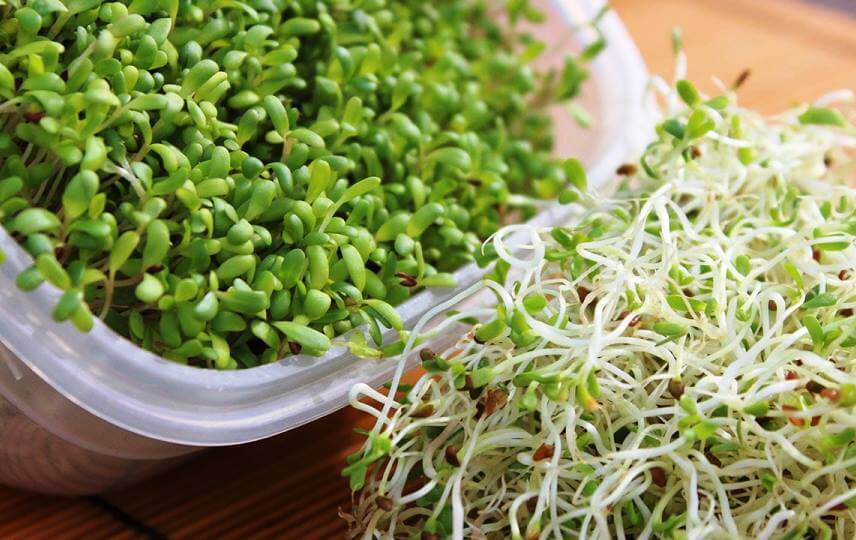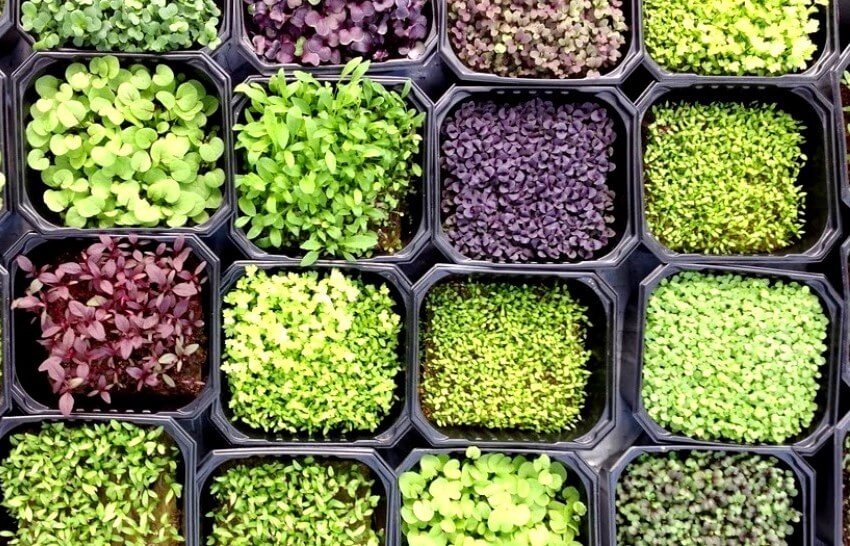Germination is a crucial stage in the development of plants, as it reactivates the metabolism of dormant seeds, triggers the embryo, and enables plant growth. This allows for a higher phytochemical content to be preserved after harvest and commercialization. Germinated seeds contain 2 to 10 times more phytochemicals than mature plants sold commercially, depending on the species, variety, and environmental conditions [1, 2].
Sprouts and microgreens are both the result of germinated seeds, but they vary in their cultivation methods and properties. Today, different types of sprouts and microgreens are produced using grains, legumes, oilseeds, cruciferous vegetables, broccoli, alfalfa, sunflower, etc., each with varying germination speeds, flavors, and chemical compositions. Sprouts and microgreens are highly sought-after products because of their health benefits, ease of production, and versatility. Owing to the widespread popularity of sprouts and microgreens, this article will delve into an exploration of their properties, characteristics, and discuss differences that set sprouts and microgreens apart.
If you are interested in this topic, you can also read
<<Clover Sprouts Benefits>> and <<Broccoli Sprouts Benefits>> articles.
About Microgreens And Sprouts
Sprouts and microgreens are creative culinary ingredients used in a variety of dishes, including sandwiches, salads, soups, desserts, and beverages. Today, sprouts and microgreens are available in the form of powders, supplements, and drinks, providing year-round access to these products despite the limited availability of fresh fruits and vegetables.
Sprouts and microgreens are both young, edible plants, but they differ in their growing process and appearance. Sprouts are germinated seeds that are typically grown in a jar with just water and air, allowing the seeds to have direct contact with water and be rinsed during the germination process. They are typically ready to eat within a few days and are harvested before the true leaves develop.
On the other hand, microgreens are cultivated in a growing medium, such as soil or a growing pad, and they are harvested after the first true leaves have developed. Microgreens require sunlight for photosynthesis, and their roots have direct contact with the growing medium Microgreens take slightly longer to grow than sprouts, usually 1-3 weeks from seed to harvest. Therefore, the main differences between sprouts and microgreens lie in their cultivation methods, growth duration, and harvest times [3].
Microgreens And Sprouts
Microgreens Vs. Sprouts: Differences And Similarities
Age And Harvest Time
Sprouts and microgreens differ in terms of their age and harvest time. Sprouts can be harvested in as little as 2 to 5 days, as they are typically consumed when the seed has just germinated and a small shoot has appeared.
Microgreens, on the other hand, take longer to grow, typically requiring between 5 and 25 days, depending on the cultivar, before they are ready for harvest. Microgreens are harvested above the ground, while the roots of the sprouts are consumed [4].
Growing Environment
The growing conditions for sprouts and microgreens differ in several aspects, such as:
Germination
Sprouts germinate in water, while microgreens grow in soil [5].
Light Requirements
- Microgreens require sunlight or grow light for healthy growth.Microgreens may struggle to grow in the absence of sufficient light, leading to the development of weak, slender plants with reduced nutritional value.
In contrast, sprouts germinate in water and typically grow in a dark environment until harvest, so they do not require exposure to light. In summary, microgreens depend on light exposure for growth, whereas sprouts do not require such illumination [6].
Ventilation
Microgreens and sprouts differ mainly in their ventilation needs. Microgreens require more ventilation and sunlight to minimize bacterial growth, while sprouts also need ventilation but require frequent washing.
Sprouts
Foodborne Infections
Due to the controlled growing environment of microgreens, they are less susceptible to foodborne infections and can grow for a longer period, typically until their first true leaves emerge. On the other hand, sprouts grow for a shorter period of time and are more susceptible to foodborne illness due to their warm and humid growing environment, which can cause dangerous bacteria to thrive [7].
Growth Time
Microgreens take longer to mature and become edible, requiring between 5 and 25 days, while sprouts can be harvested in 3 to 5 days. Microgreens require approximately 78% more time to grow compared to sprouts. variation in growth duration is due to the fact that while the sprouts are germinated in water and harvested at an early stage of growth, microgreens are grown in soil and given at least 3-5 days to develop their first true leaves [8].
Microgreens
Harvesting
The time and technique required for harvesting differ between microgreens and sprouts. Sprouts are typically grown without soil, and they can be harvested 3 to 5 days after reaching maturity for consumption. Conversely, microgreens are grown in soil or a growing medium and require a longer time to harvest, ranging from 5 to 25 days. To avoid contamination, microgreens are collected by cutting slightly above the soil line, 1-5 centimeters from the ground [7].
Plant Parts Consumed
Microgreens are typically consumed by eating the stems and leaves, usually without the roots, while the sprouts are generally consumed whole, including the seed and stem. Microgreens, resembling miniature versions of full-grown plants with their first set of true leaves, are harvested at a more mature stage, typically when they reach a length of 1 to 2 inches. Conversely, sprouts are harvested before true leaves appear because they are picked at an earlier stage—usually within three to five days of growth.
Shelf Life
Microgreens have a longer shelf life than sprouts because of their more developed plant structure. When stored correctly, they can last for more than 10 days in the refrigerator. But, as the sprouts are highly perishable, they should be consumed immediately. Depending on the type of bud and how to store it, their shelf life is different.
Most sprouts can be stored in a plastic bag in the refrigerator for up to three days. Both sprouts and microgreens must be stored correctly to preserve their freshness and nutritional content. This involves removing the husk or seed coat, which can deteriorate over time, and ensuring proper humidity and ventilation [7, 9].
Risk of Bacterial Growth
The risk of bacterial growth in microgreens is significantly lower than in sprouts, making microgreens a safer choice in terms of food safety [10].
Nutritional Value
Sprouts and microgreens differ in their nutritional value and nutrient composition, which can have varying effects on health [3, 10,11]:
Nutritional Content
Sprouts and microgreens have different nutritional profiles. Sprouts are a rich source of amino acids, pectins, and sugars, while microgreens are high in carotenoids, chlorophylls, and organic acids.
Antioxidant Capacity
Sprouts have a robust antioxidant capacity because of their high content of specific compounds, while microgreens are abundant in vitamins and other phytochemicals. However, some species of microgreens contain four to six times more antioxidants than mature plants.
Phytochemical Compounds
Microgreens are known for their high levels of carotenoids, chlorophylls, and organic acids, while sprouts are abundant in natural antioxidants such as phenolic compounds, carotenoids, and chlorophylls.
Protein Content
Sprouts are considered a good source of incomplete protein, while microgreens may contain a higher concentration of nutrients, including protein, than their fully grown counterparts.
Mineral Content
Microgreens are abundant in potassium, iron, zinc, magnesium, and copper. The concentrations of essential minerals often increase as the plants grow. This can have a positive impact on health by addressing nutrient deficiencies.
Vitamin Levels
Microgreens often contain higher amounts of vitamins than their more mature counterparts, with some varieties having up to 40 times higher vitamin levels than fully grown plants.
Glycemic Index
Both sprouts and microgreens are known for their low caloric value and low glycemic index, making them suitable for individuals who are mindful of their blood sugar levels and overall caloric intake.
Effects on digestion
Sprouts aid in breaking down natural anti-nutrients in nuts, grains, and seeds, which makes them easier to digest, particularly for patients with digestive or autoimmune issues .
Applications
Sprouts and microgreens differ in their taste, texture, and growth time. The sprouts, which take less than a week to grow, are great for adding crunch to foods and have a relatively mild flavor. They are typically used in sandwiches, salads, and as a topping.
On the other hand, microgreens, which take about one to three weeks to grow, are packed with flavor and are often used as a condiment. They contribute vibrant colors, offer a stronger flavor, and are packed with vitamins and antioxidants, making them a nutritious addition to any meal [12].

